Ageing of Crumb Rubber Modified Bituminous Binders under Real Service Conditions
Abstract
:1. Introduction
2. Methodology
2.1. Materials
2.2. Testing Plan
3. Analysis of Results
4. Conclusions
Author Contributions
Funding
Institutional Review Board Statement
Informed Consent Statement
Data Availability Statement
Conflicts of Interest
References
- Picado-Santos, L.G.; Capitão, S.D.; Neves, J.M. Crumb rubber asphalt mixtures: A literature review. Constr. Build. Mater. 2020, 247, 118577. [Google Scholar] [CrossRef]
- Moreno, F.; Sol, M.; Martín, J.; Pérez, M.; Rubio, M.C. The effect of crumb rubber modifier on the resistance of asphalt mixes to plastic deformations. Mater. Des. 2013, 47, 274–280. [Google Scholar] [CrossRef]
- Van Kirk, J.L.; Holleran, G. Reduced Thickness asphalt Rubber Concrete leads to cost effective pavement performance. In Proceedings of the 1st International Conference World of Pavements, Sydney, Australia, 20–24 February 2000. [Google Scholar]
- Soon, J.L.; Akisetty, C.; Amirkhanian, S.N. The effect of crumb rubber modifier (CRM) on the performance properties of rubberized binders in HMA pavements. Constr. Build. Mater. 2008, 22, 1368–1376. [Google Scholar]
- Raad, L.; Saboundjian, S.; Minassian, G. Field aging effects on the fatigue of asphalt concrete and asphalt-rubber concrete. Transp. Res. Rec. 2001, 1767, 126–134. [Google Scholar] [CrossRef]
- Sacramento County-Department of Environmental Review and Assessment; Bollard & Brennan. Report on Status of Rubberized Asphalt Traffic Noise Reduction in Sacramento County; Sacramento County Public Work Agency: Sacramento, CA, USA, 1999.
- McNerney, M.; Landsberger, B.J.; Turen, T.; Pandelides, A. Comparative field measurements of tyre/pavement noise of selected Texas pavements. Transp. Res. Rec. 1998, 1626, 78–84. [Google Scholar] [CrossRef]
- State of California Department of Transportation. Asphalt Rubber Usage Guide; State of California Department of Transportation: Sacramento, CA, USA, 2006.
- Amirkhanian, S.N. Utilization of Crumb Rubber in Asphaltic Concrete Mixtures. South Carolina’s Experience; Department of Civil Engineering, Clemson University: Clemson, SC, USA, 2001. [Google Scholar]
- Updyke, E.; Diaz, I. Rubberized Asphalt Concrete Case Studies. In Proceedings of the 2008 California Pavement Preservation Conference, Newport Beach, CA, USA, 9–10 April 2008. [Google Scholar]
- Shatnawi, S.R. Performance of Asphalt Rubber Mixes in California. Int. J. Pavement Eng. 2001, 2, 1–16. [Google Scholar] [CrossRef]
- Tahmoressi, M. Evaluation of Asphalt Rubber Pavements in Texas; Report prepared for Rubber Pavements Association; PaveTex Engineering and Testing, Inc.: Dripping Springs, TX, USA, 2001. [Google Scholar]
- Choubane, B.; Sholar, G.A.; Musselman, J.A.; Page, G.C. Long Term Performance Evaluation of Asphalt-Rubber Surface Mixes; State of Florida Research Report FL/DOT/SMO/98-431; State of Florida Department of Transportation: Tallahassee, FL, USA, 1998. [Google Scholar]
- Hicks, R.G.; Epps, J.A. Life Cycle Cost Analysis of Asphalt-Rubber Paving Materials; Final Report Volumes I and II; Rubber Pavements Association: Tempe, AZ, USA, 1999. [Google Scholar]
- Jung, J.-S.; Kaloush, K.E.; Way, G. Life Cycle Cost Analysis: Conventional versus Asphalt Rubber Pavements; Rubber Pavements Association: Tempe, AZ, USA, 2002. [Google Scholar]
- Sousa, J.; Way, G.; Carlson, D.D. Cost Benefit Analysis and Energy Consumption of Scrap Tire Management Options; Rubber Pavements Association: Tempe, AZ, USA, 2001. [Google Scholar]
- Signus, Sistema Integrado de Gestión de Neumáticos Usados. Available online: www.signus.es (accessed on 20 May 2022).
- CEDEX (Centro de Estudios y Experimentación de Obras Públicas). Manual de Empleo de Caucho de NFU en Mezclas Bituminosas; Ministerio de Fomento, Ministerio de Medio Ambiente: Madrid, Spain, 2007. [Google Scholar]
- Dirección General de Carreteras. Pliego de Prescripciones Técnicas Generales para Obras de Carreteras y Puentes PG-3; Ministerio de Fomento: Madrid, Spain, 2019.
- EN 1308-2; Bituminous Mixtures. Materials Specifications—Part 2: Asphalt Concrete for Very Thin Layers. AENOR, Asociación Española de Normalización y Certificación: Madrid, Spain, 2012.
- Bressi, S.; Fiorentini, N.; Huang, J.; Losa, M. Crumb Rubber Modifier in Road Asphalt Pavements: State of the Art and Statistics. Coatings 2019, 9, 384. [Google Scholar] [CrossRef]
- EN 12697-6; Bituminous Mixtures. Test Methods for Hot Mix Asphalt—Part 6: Determination of Bulk Density of Bituminous Specimens. AENOR, Asociación Española de Normalización y Certificación: Madrid, Spain, 2012.
- EN 12697-3; Bituminous Mixtures. Test Methods for Hot Mix Asphalt—Part 3: Bitumen Recovery: Rotary Evaporator. AENOR, Asociación Española de Normalización y Certificación: Madrid, Spain, 2013.
- EN 14770; Bitumen and Bituminous Binders—Determination of Complex Shear Modulus and Phase Angle—Dynamic Shear Rheometer (DSR). AENOR, Asociación Española de Normalización y Certificación: Madrid, Spain, 2012.
- EN 16659; Bitumen and Bituminous Binders—Multiple Stress Creep and Recovery Test (MSCRT). AENOR, Asociación Española de Normalización y Certificación: Madrid, Spain, 2016.
- Moreno-Navarro, F.; Tauste, R.; Sol-Sánchez, M.; Rubio-Gámez, M.C. New approach for characterising the performance of asphalt binders through the multiple stress creep and recovery test. Road Mater. Pavement Des. 2019, 20 (Suppl. 1), S500–S520. [Google Scholar] [CrossRef]
- Miró, R.; Martínez, A.; Moreno-Navarro, F.; Rubio-Gámez, M.C. Effect of ageing and temperature on the fatigue behaviour of bitumens. Mater. Des. 2015, 86, 129–137. [Google Scholar] [CrossRef]
- Brasileiro, L.L.; Moreno-Navarro, F.; Tauste Martinez, R.; Sol-Sánchez, M.; Matos, J.M.E.; Rubio-Gámez, M.C. Study of the feasibility of producing modified asphalt bitumens using flakes made from recycled polymers. Constr. Build. Mater. 2019, 208, 269–282. [Google Scholar] [CrossRef]
- Wang, S.; Huang, W.; Kang, A. Laboratory evaluation of the properties of high-cured crumb rubber modified asphalt containing sulfur and polymer after the oxidative aging procedure. Constr. Build. Mater. 2021, 304, 124611. [Google Scholar] [CrossRef]
- Wang, S.; Huang, W.; Liu, X.; Lin, P. Influence of high content crumb rubber and different preparation methods on properties of asphalt under different aging conditions: Chemical properties, rheological properties, and fatigue performance. Constr. Build. Mater. 2022, 327, 126937. [Google Scholar] [CrossRef]

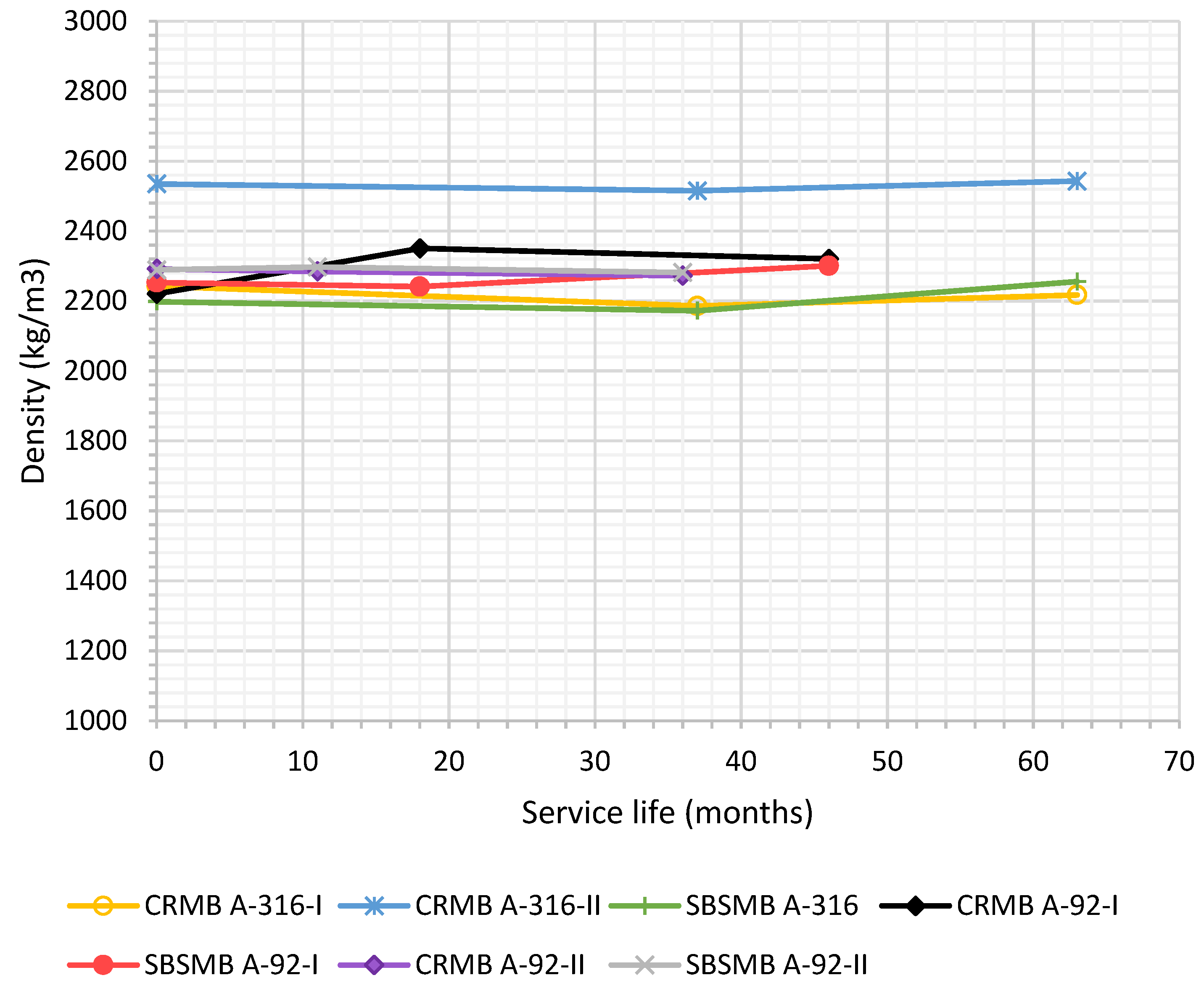

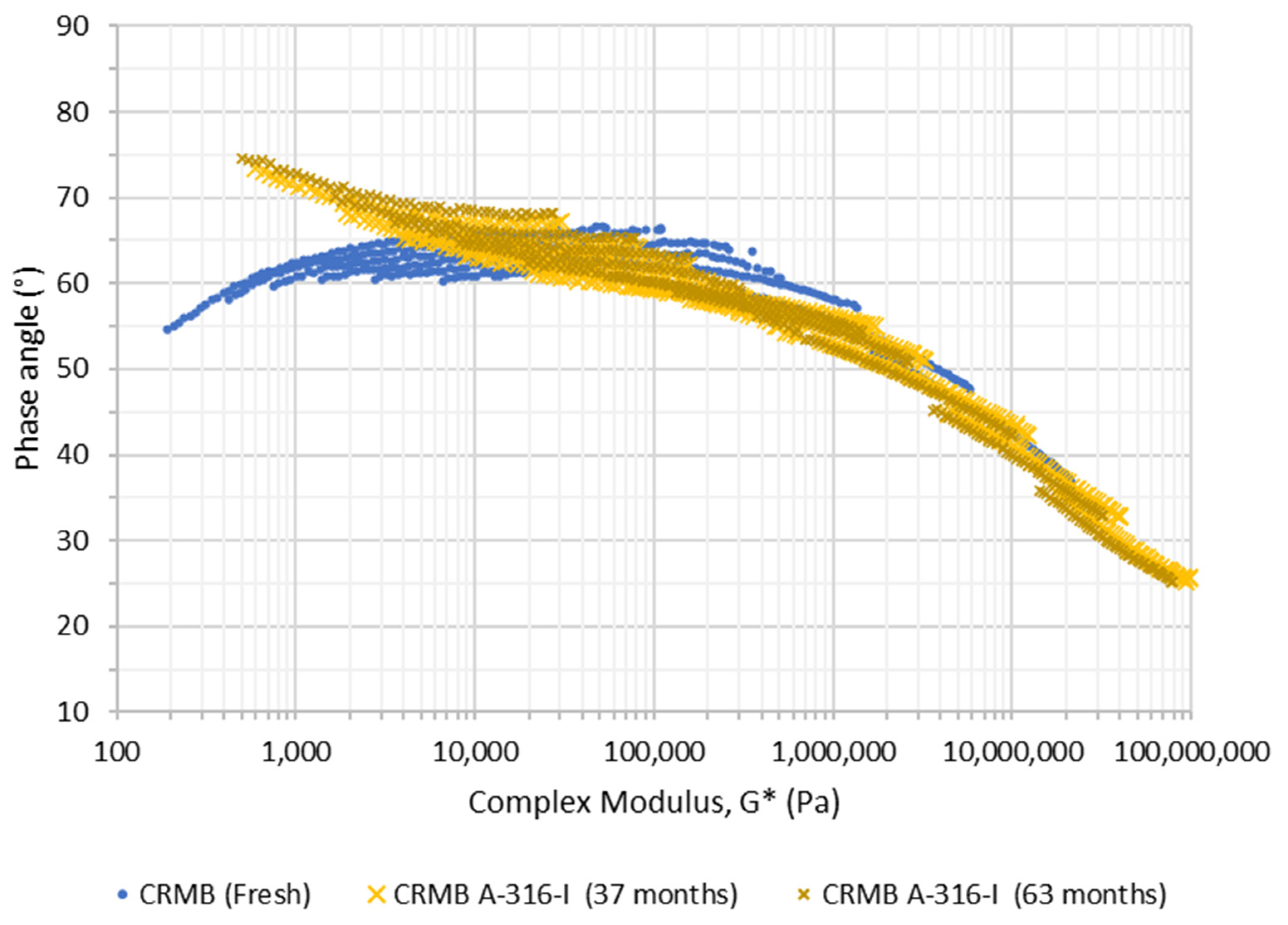

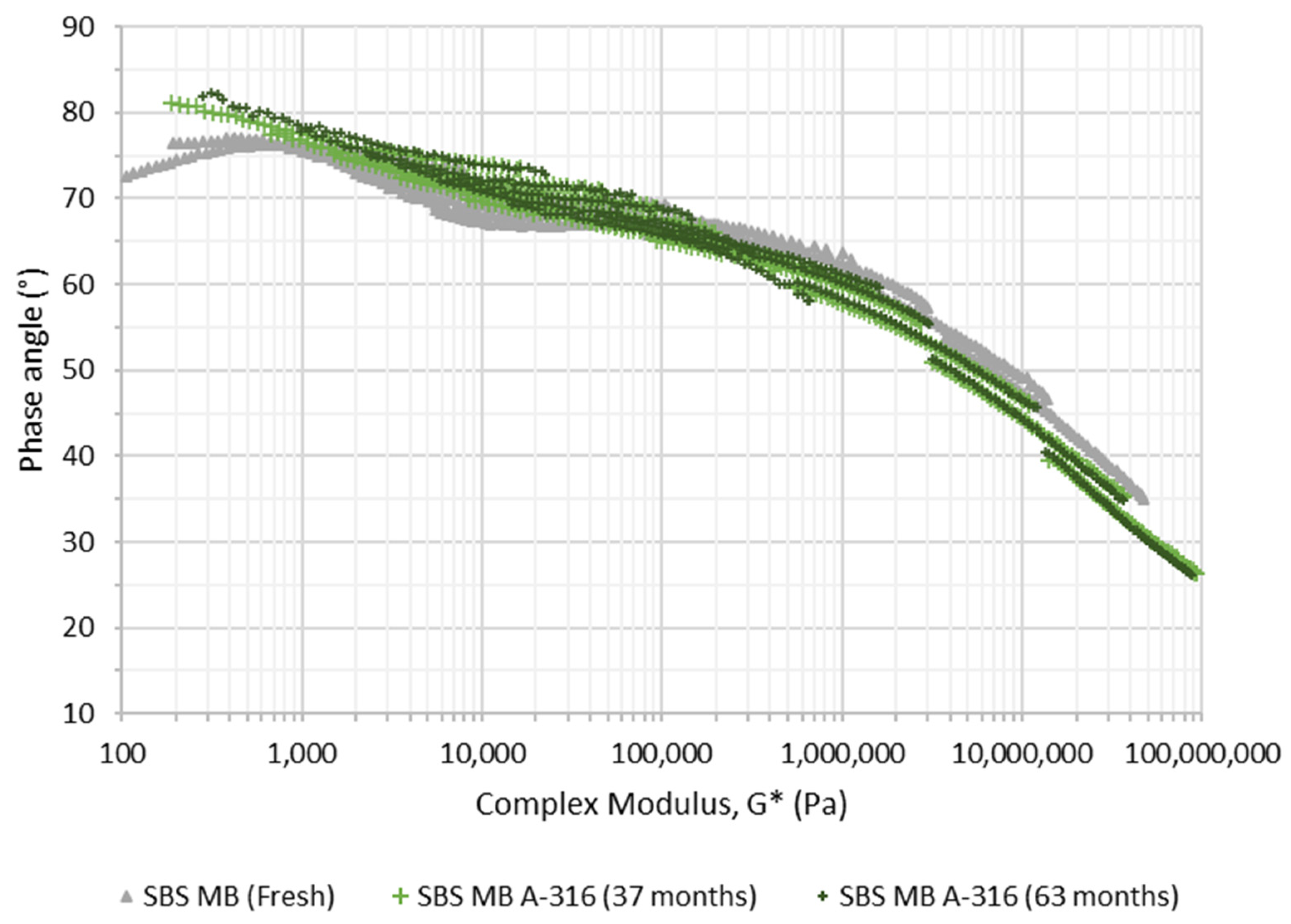

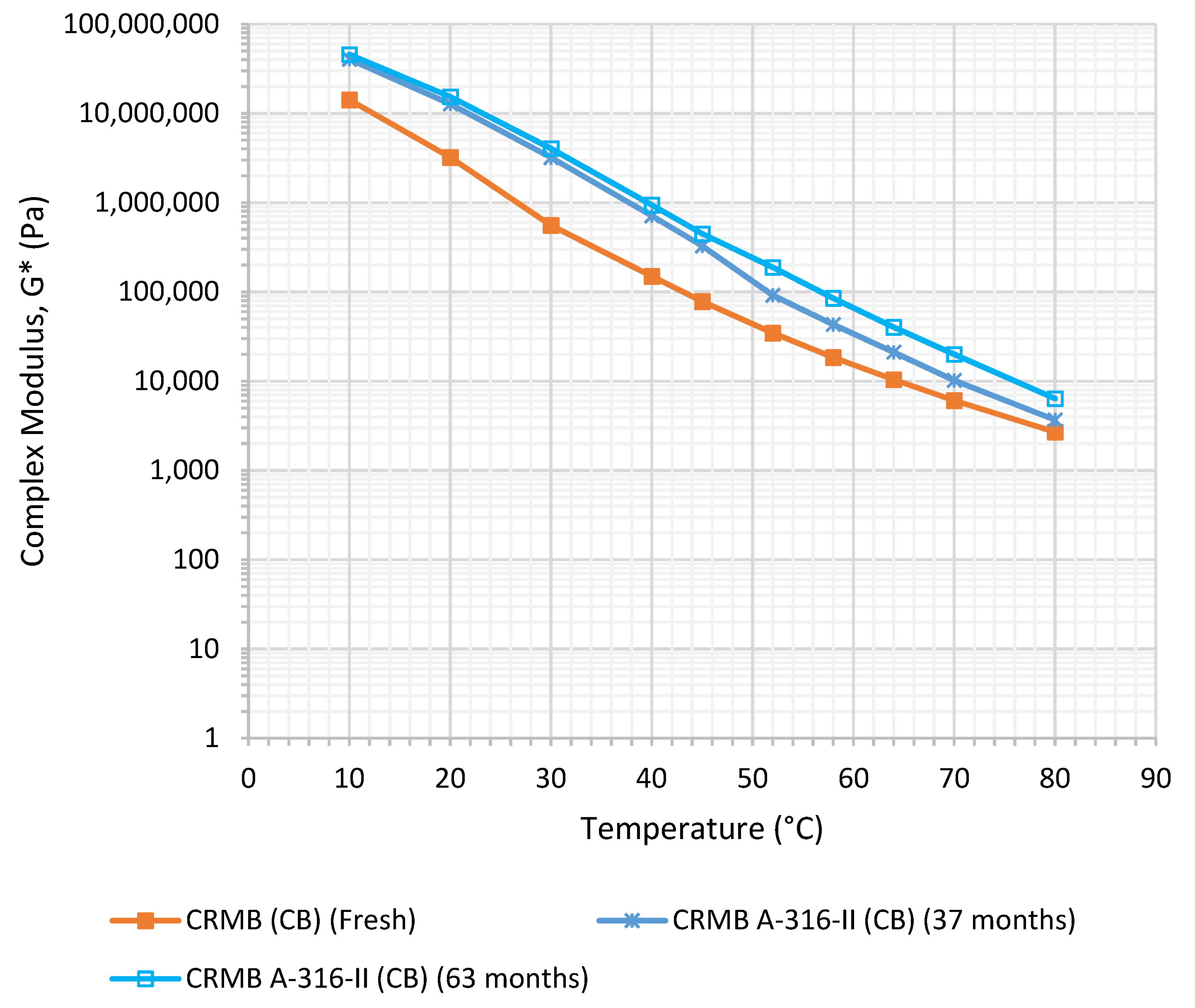
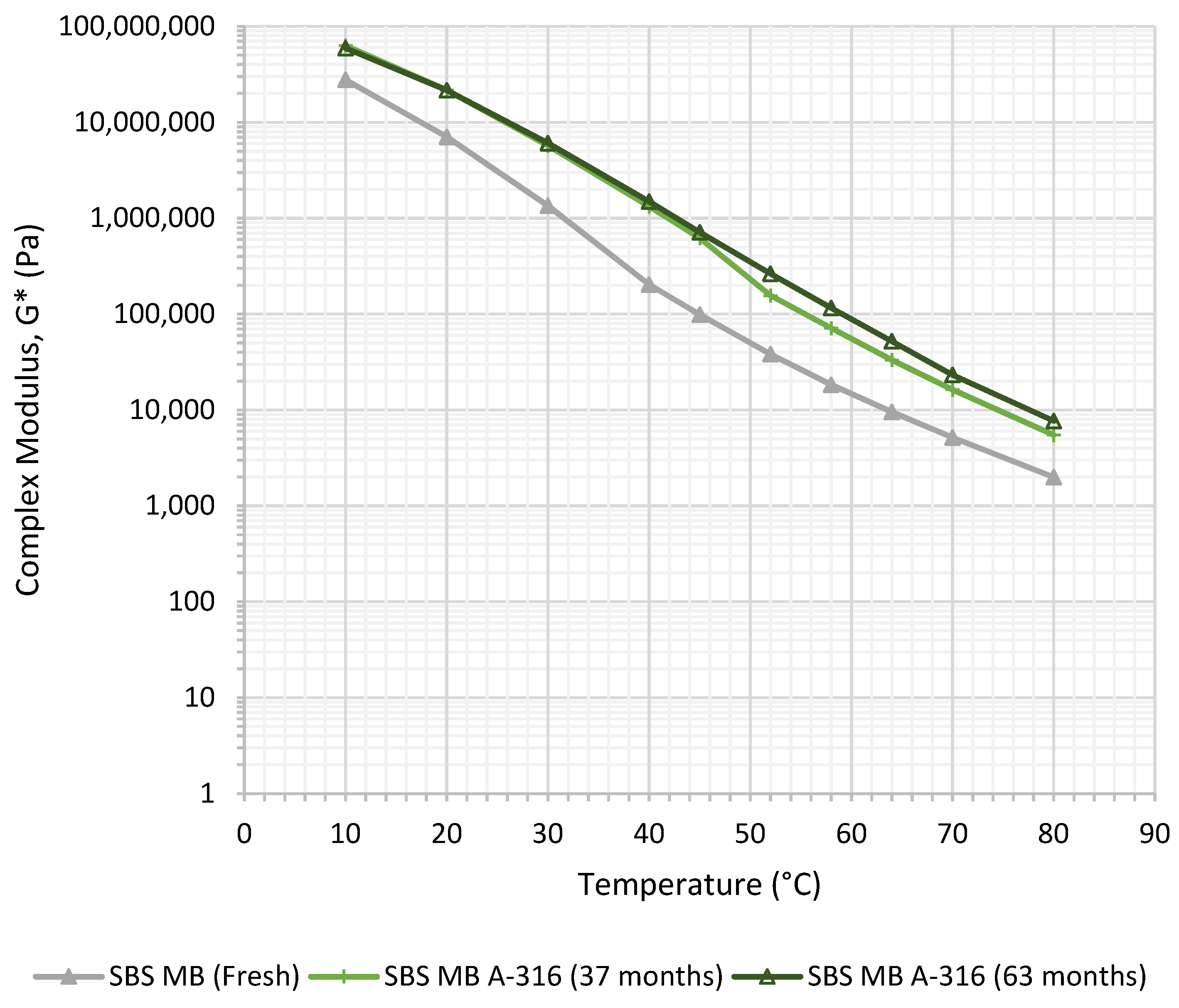
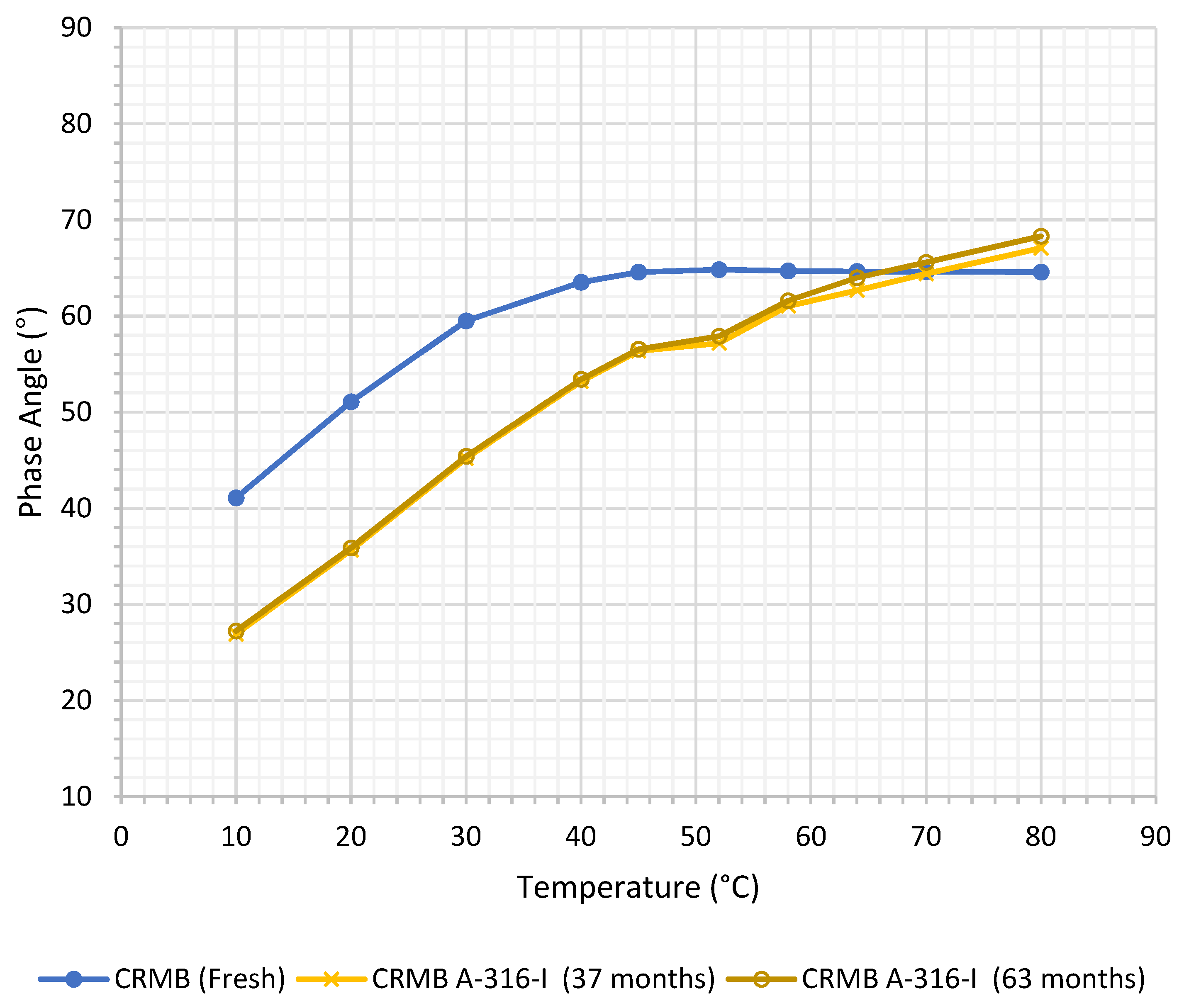
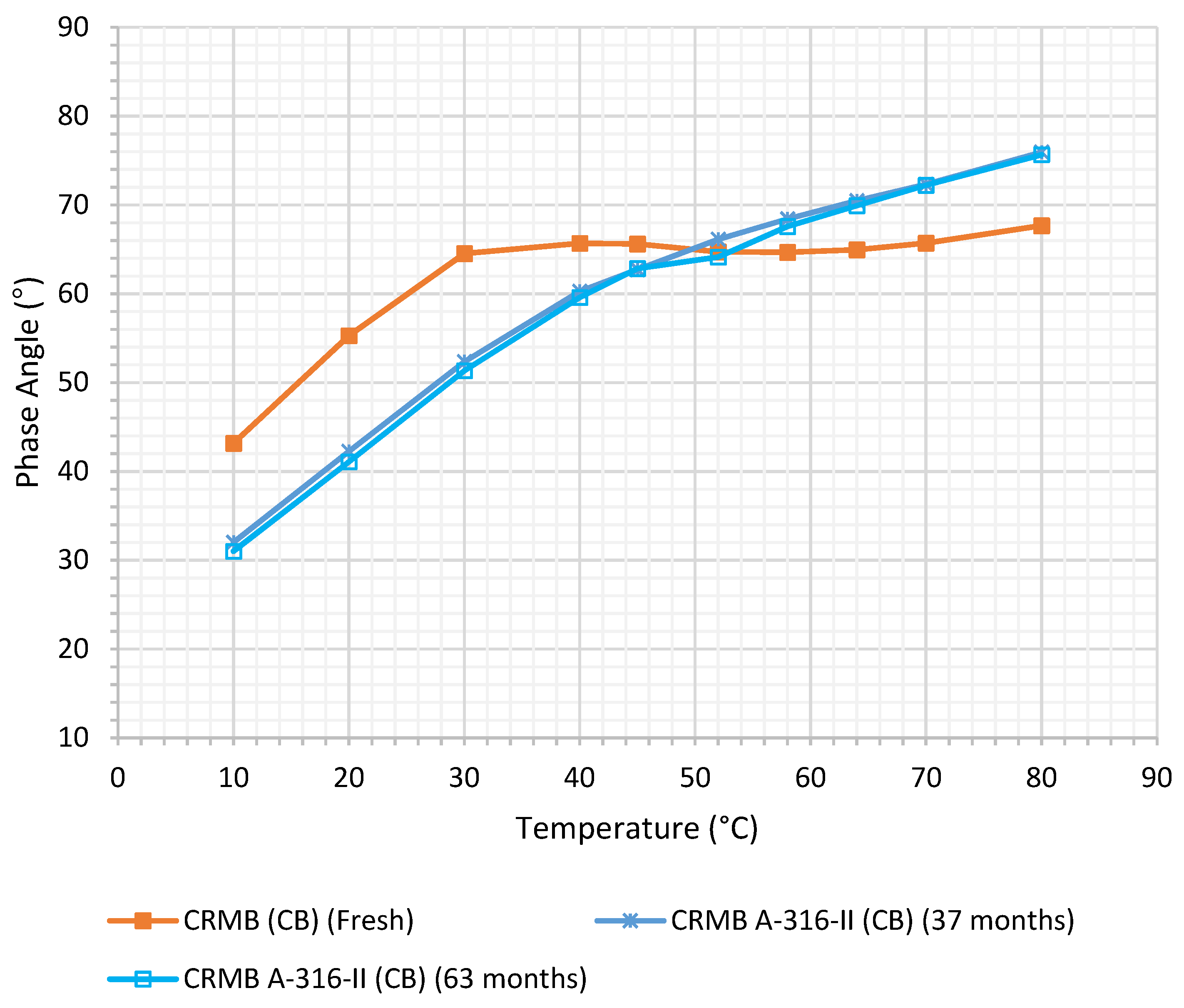


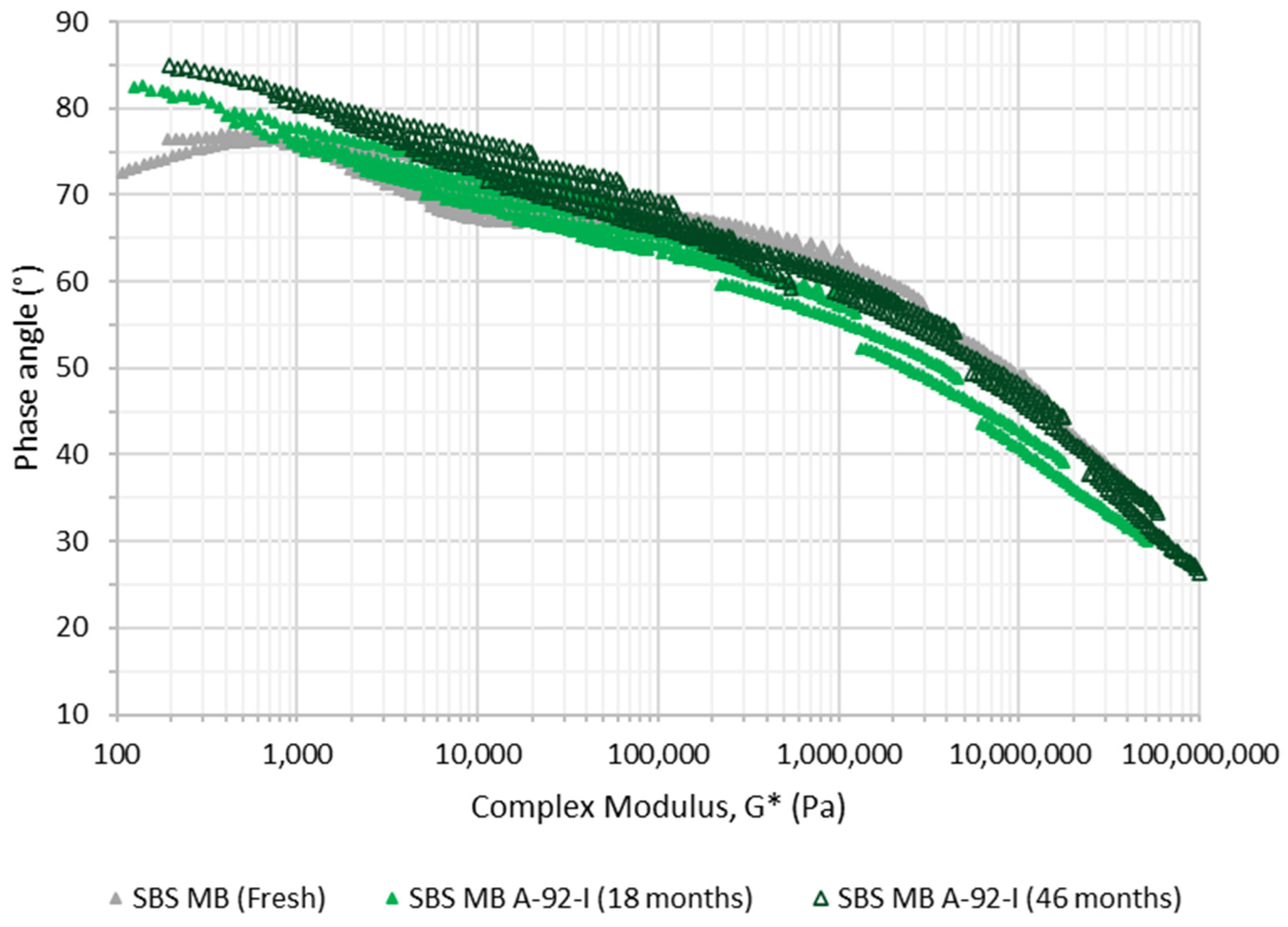
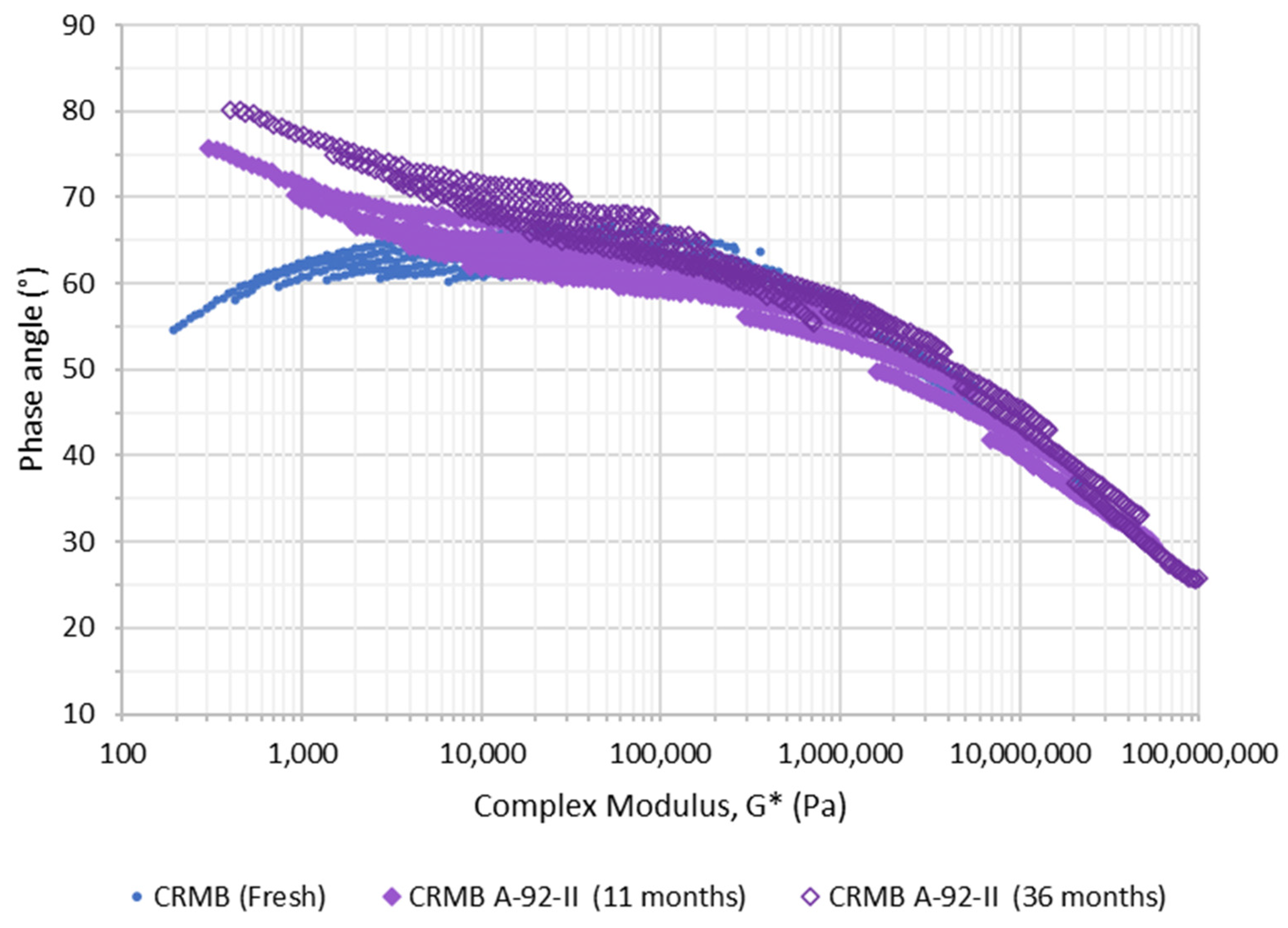
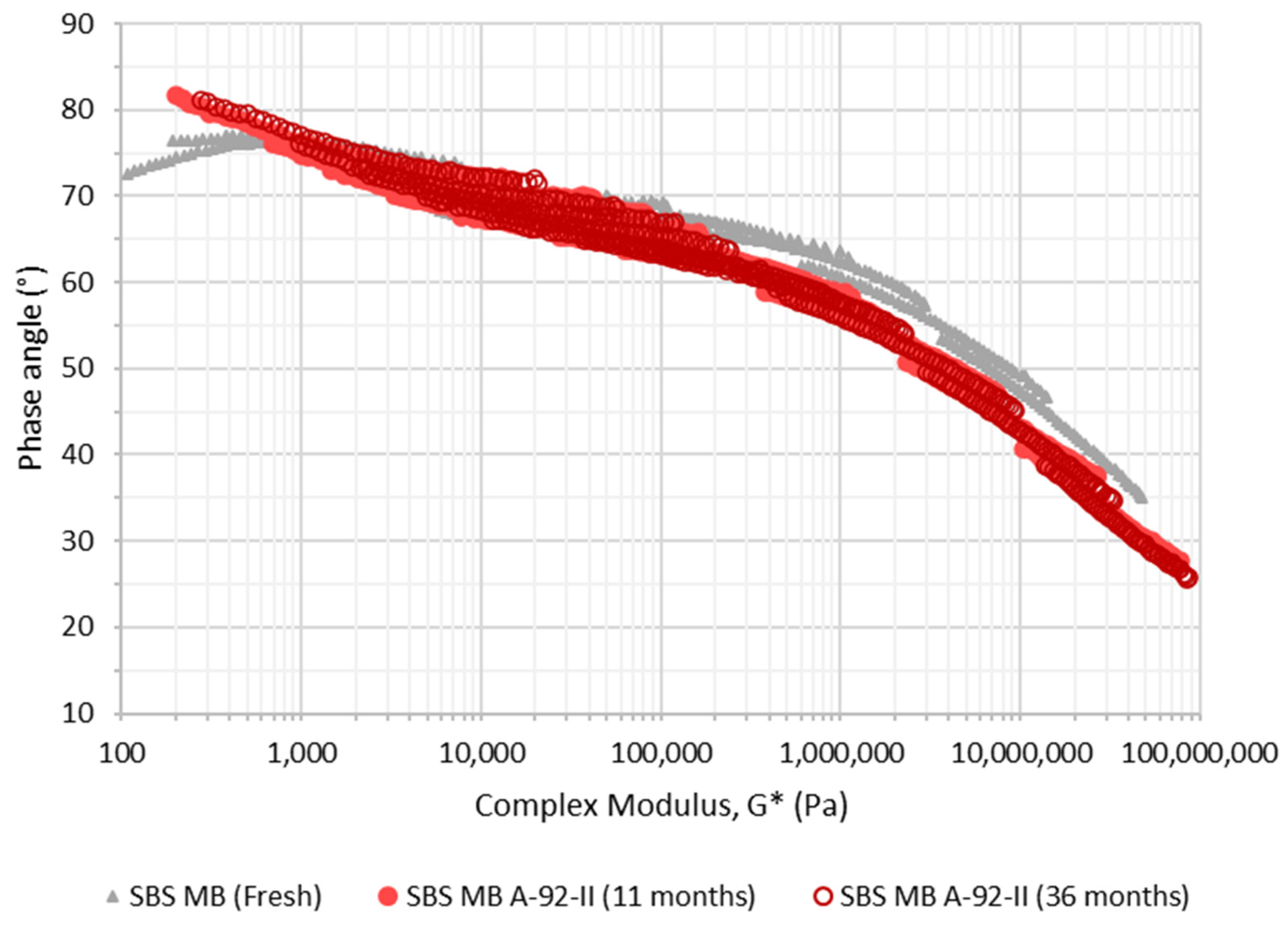

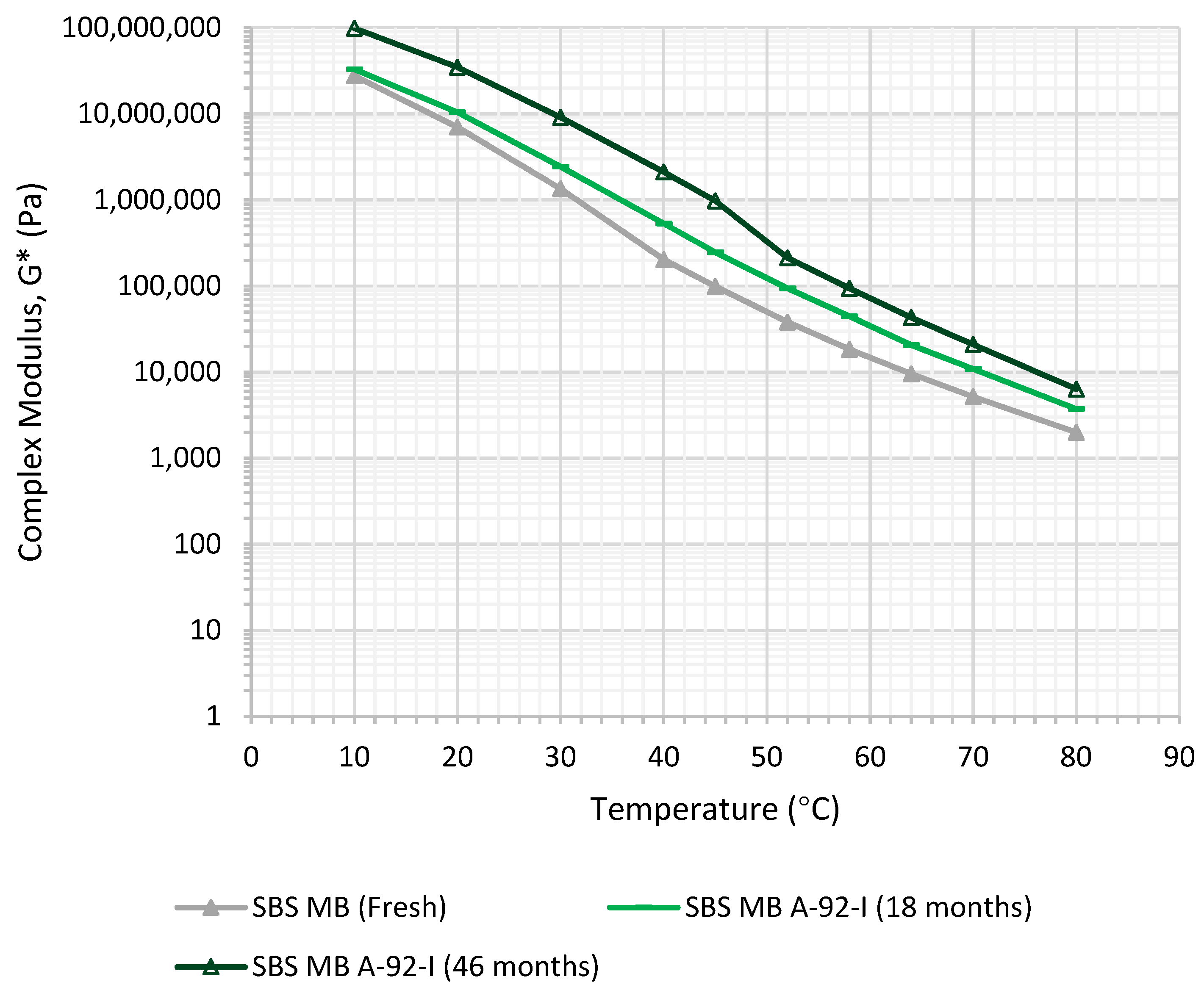
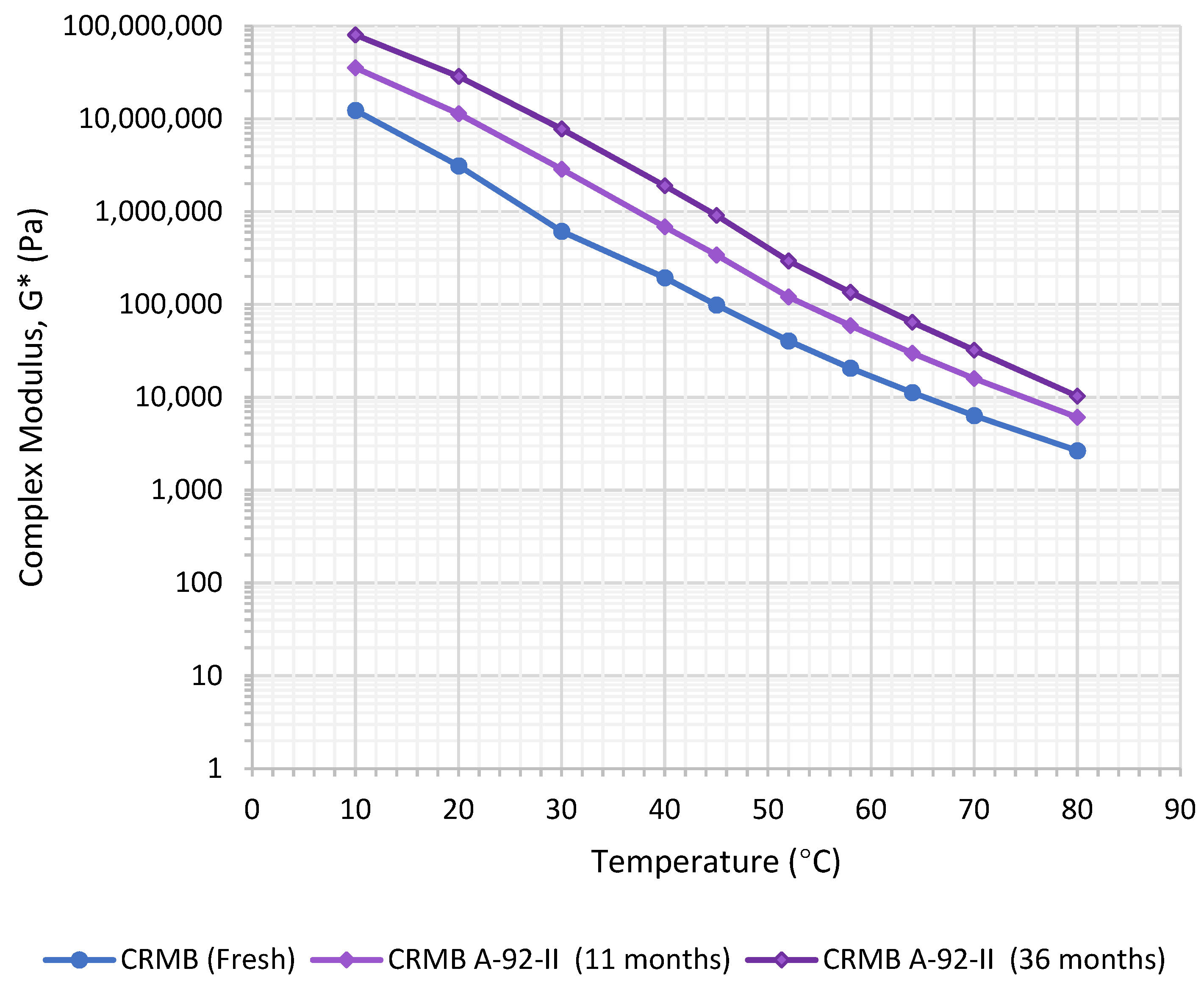
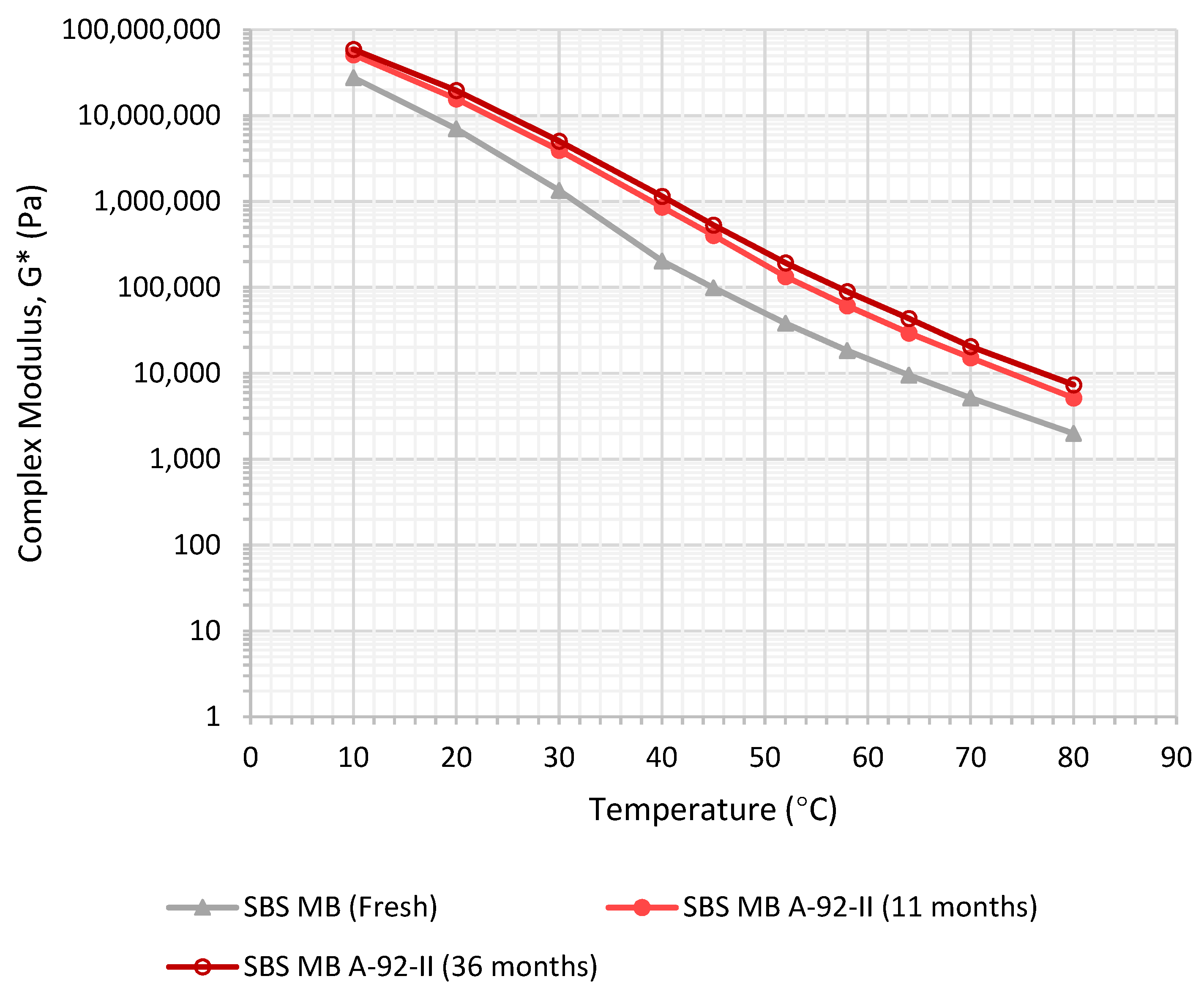
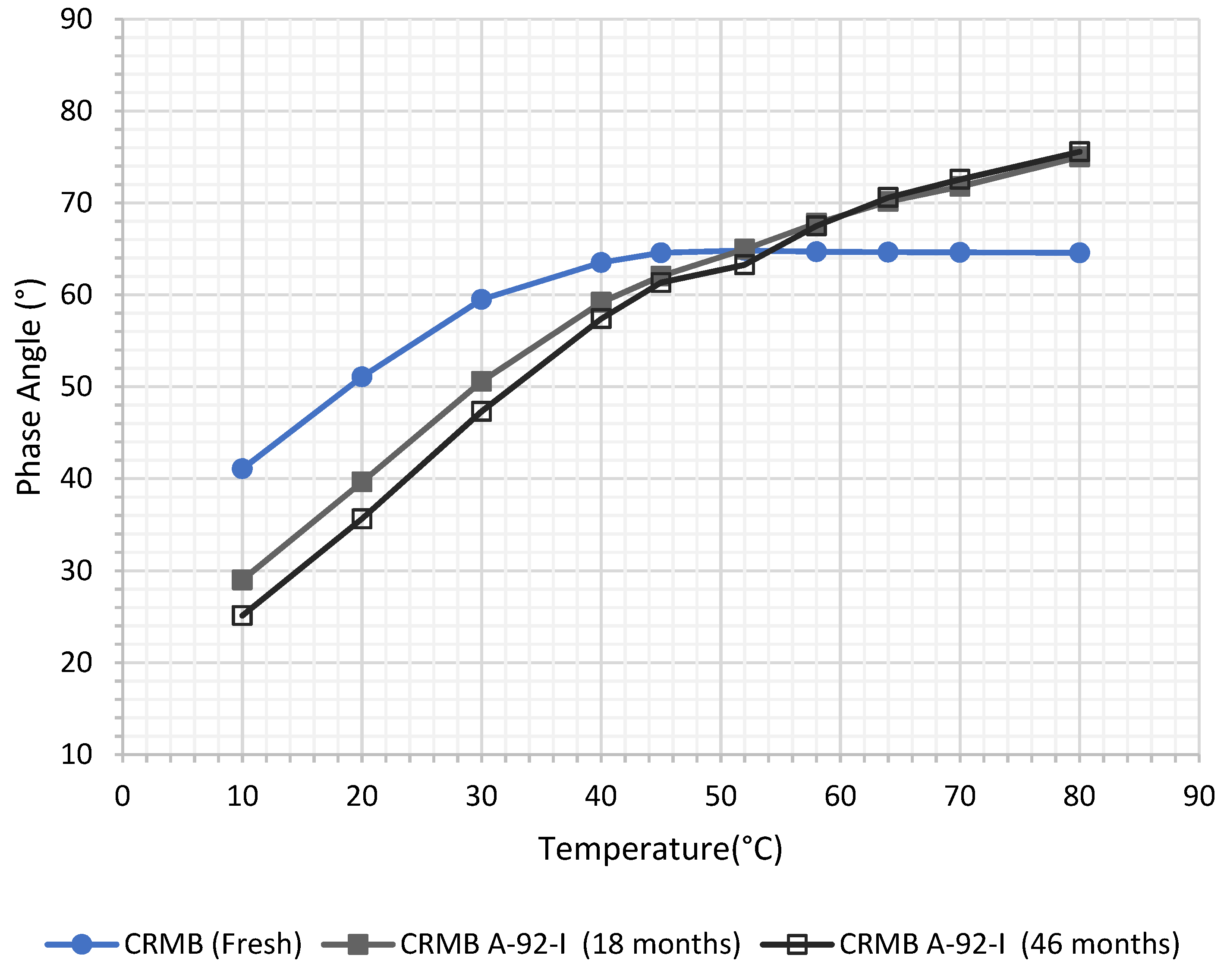
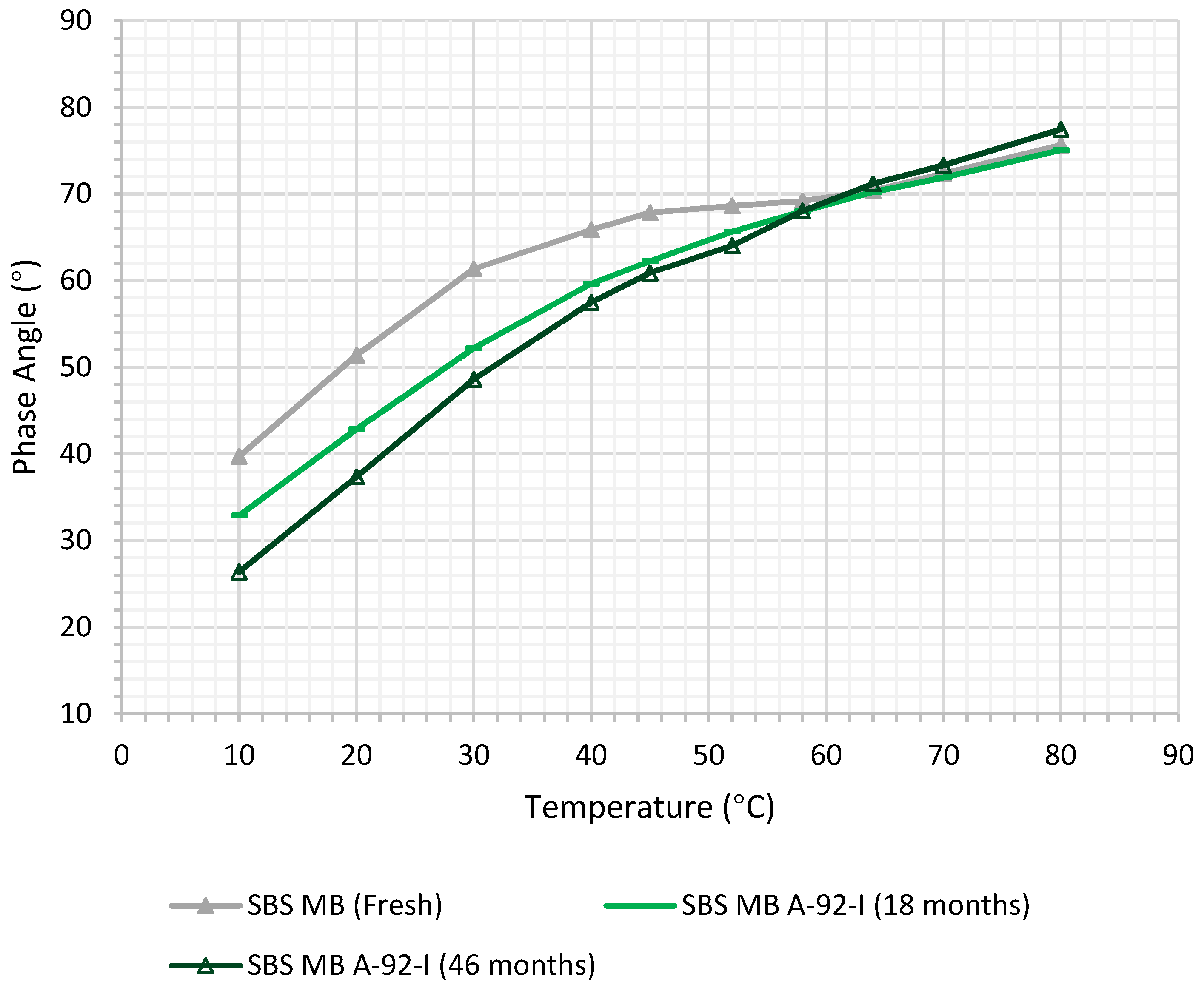
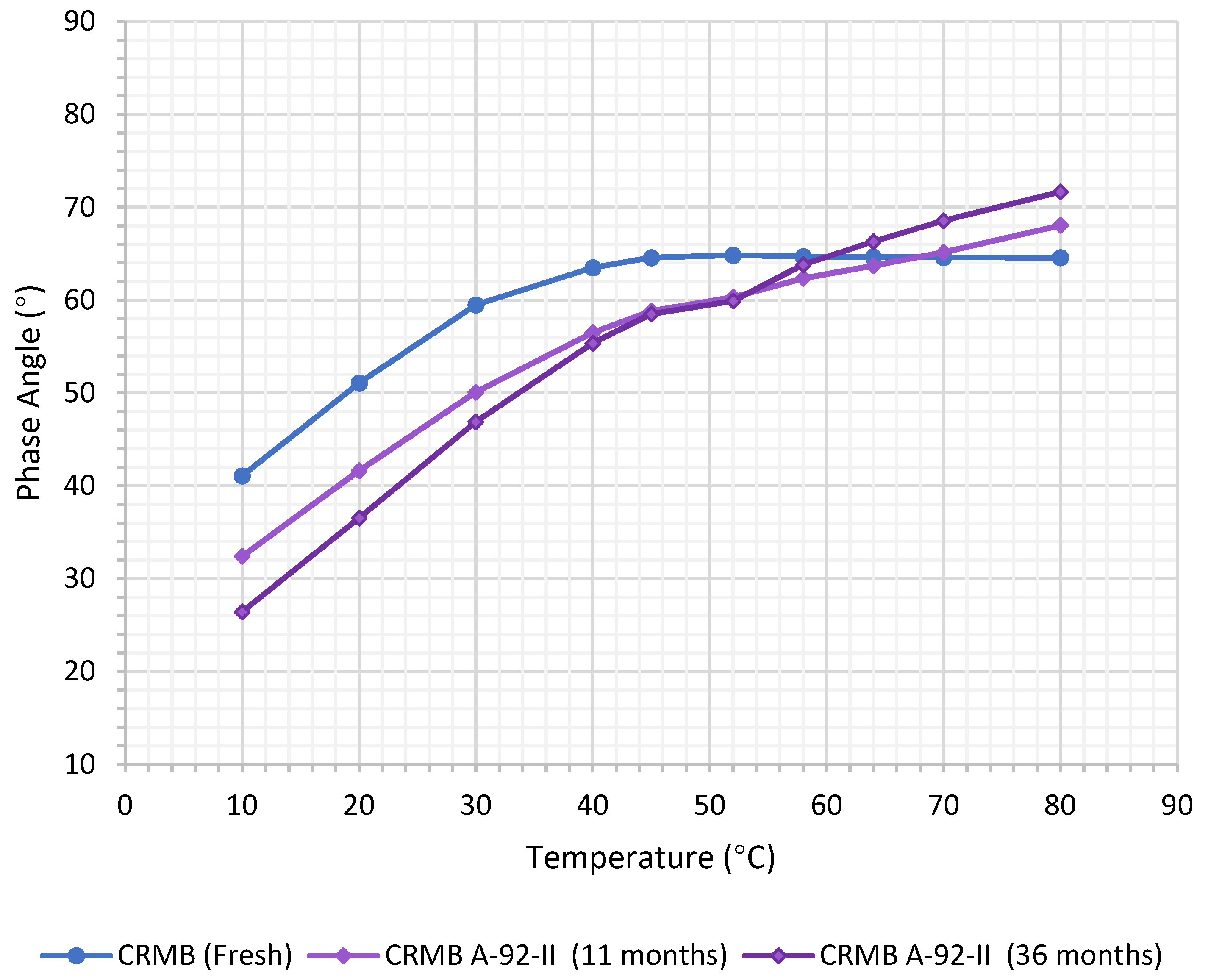
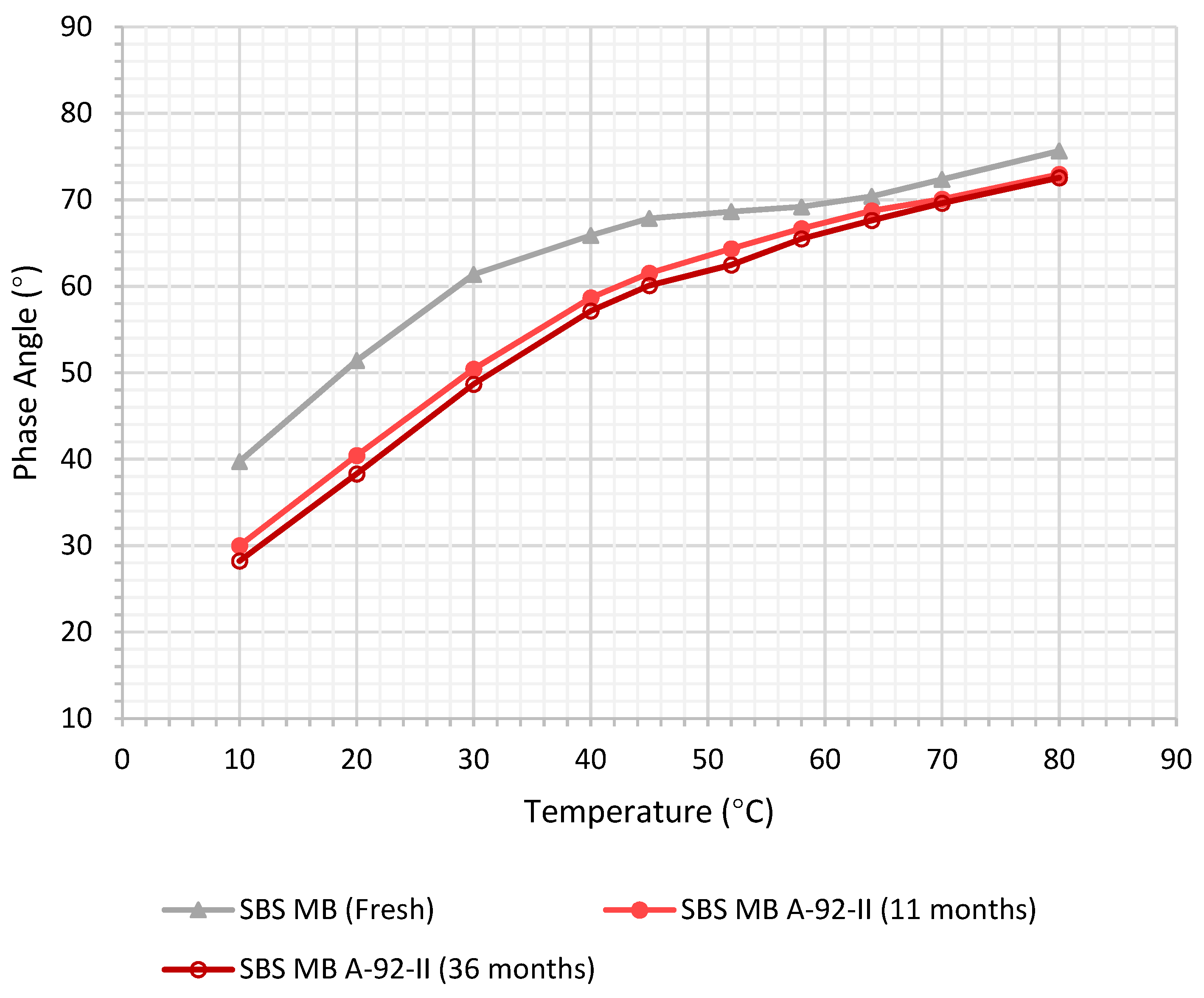

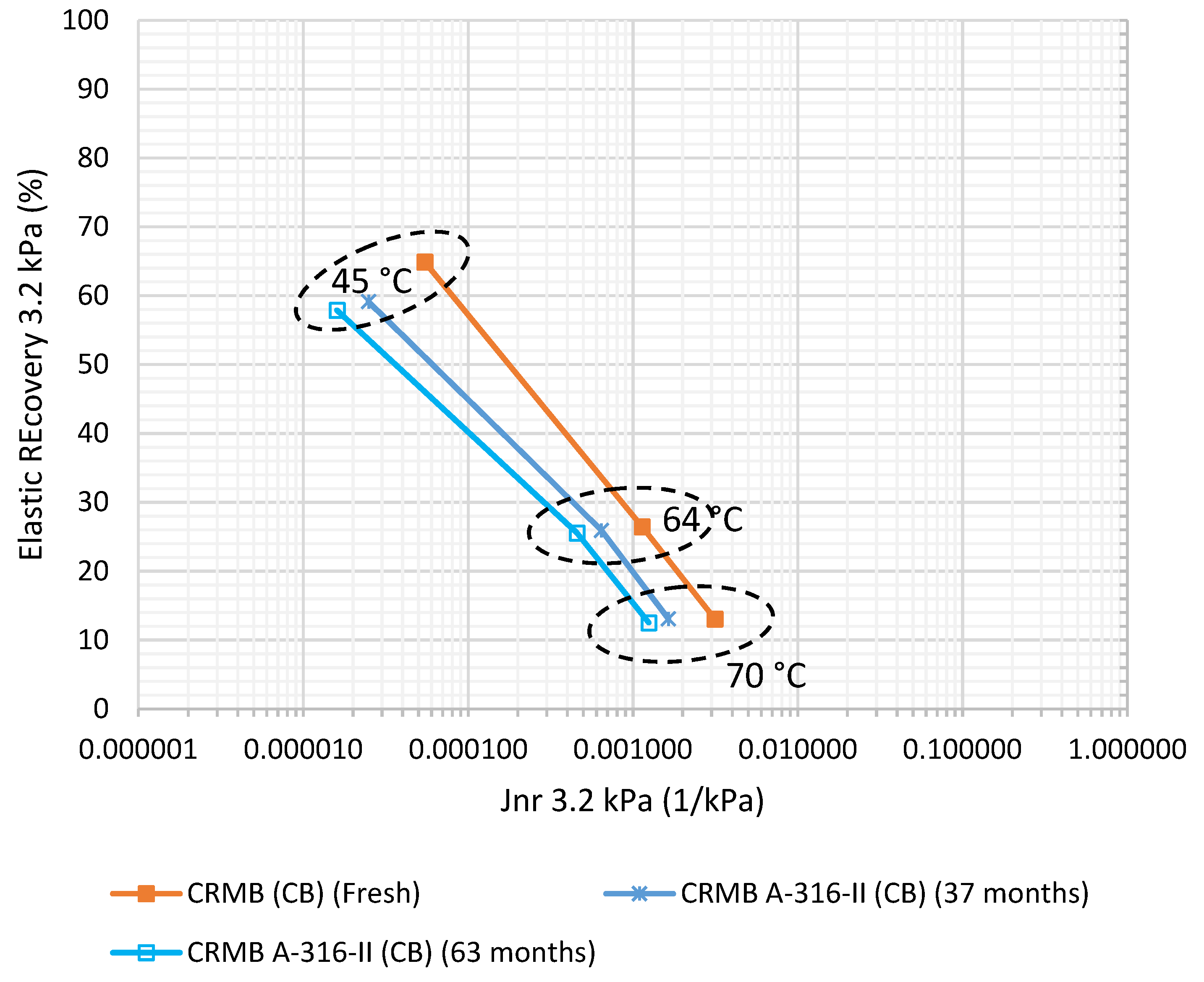
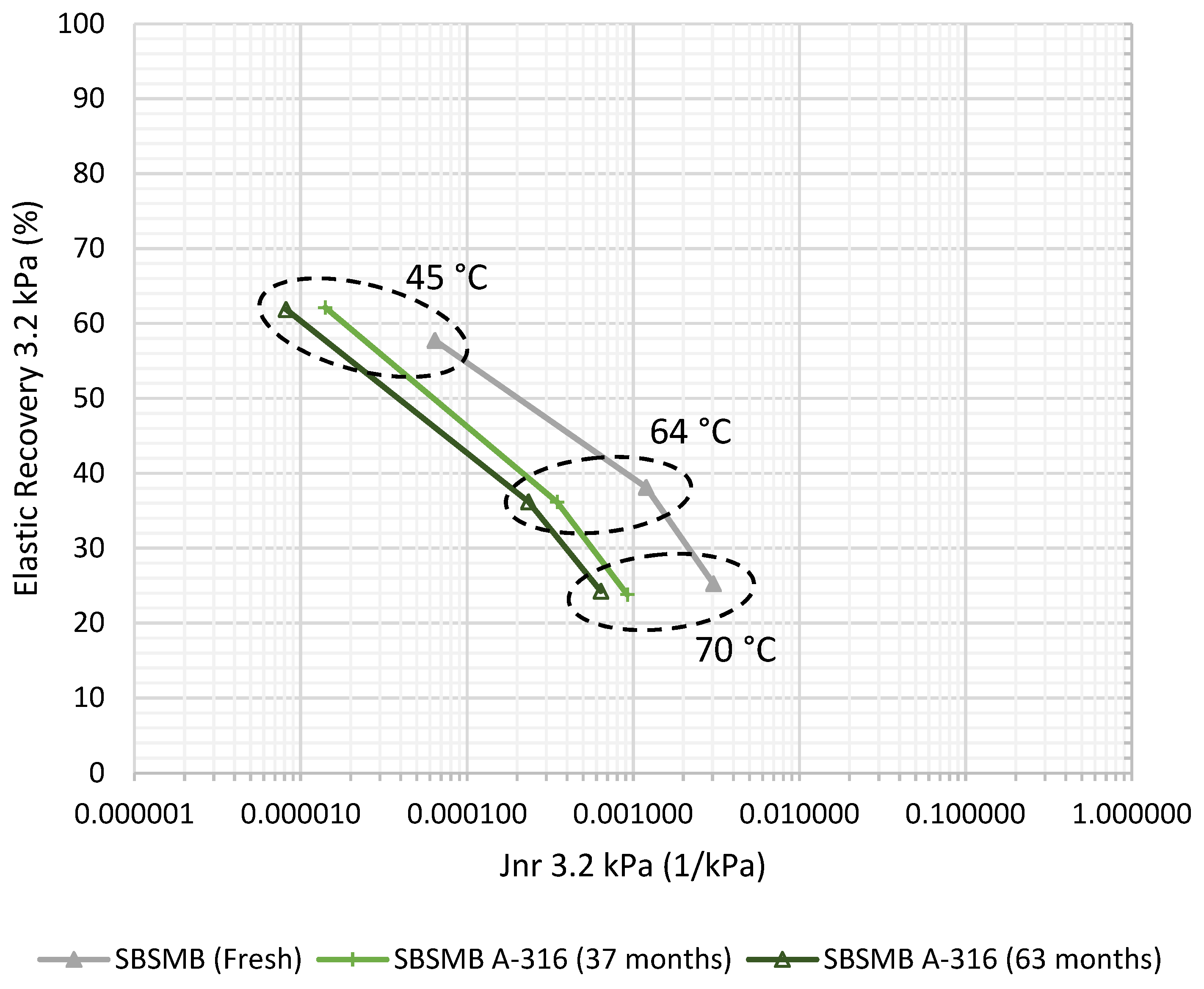
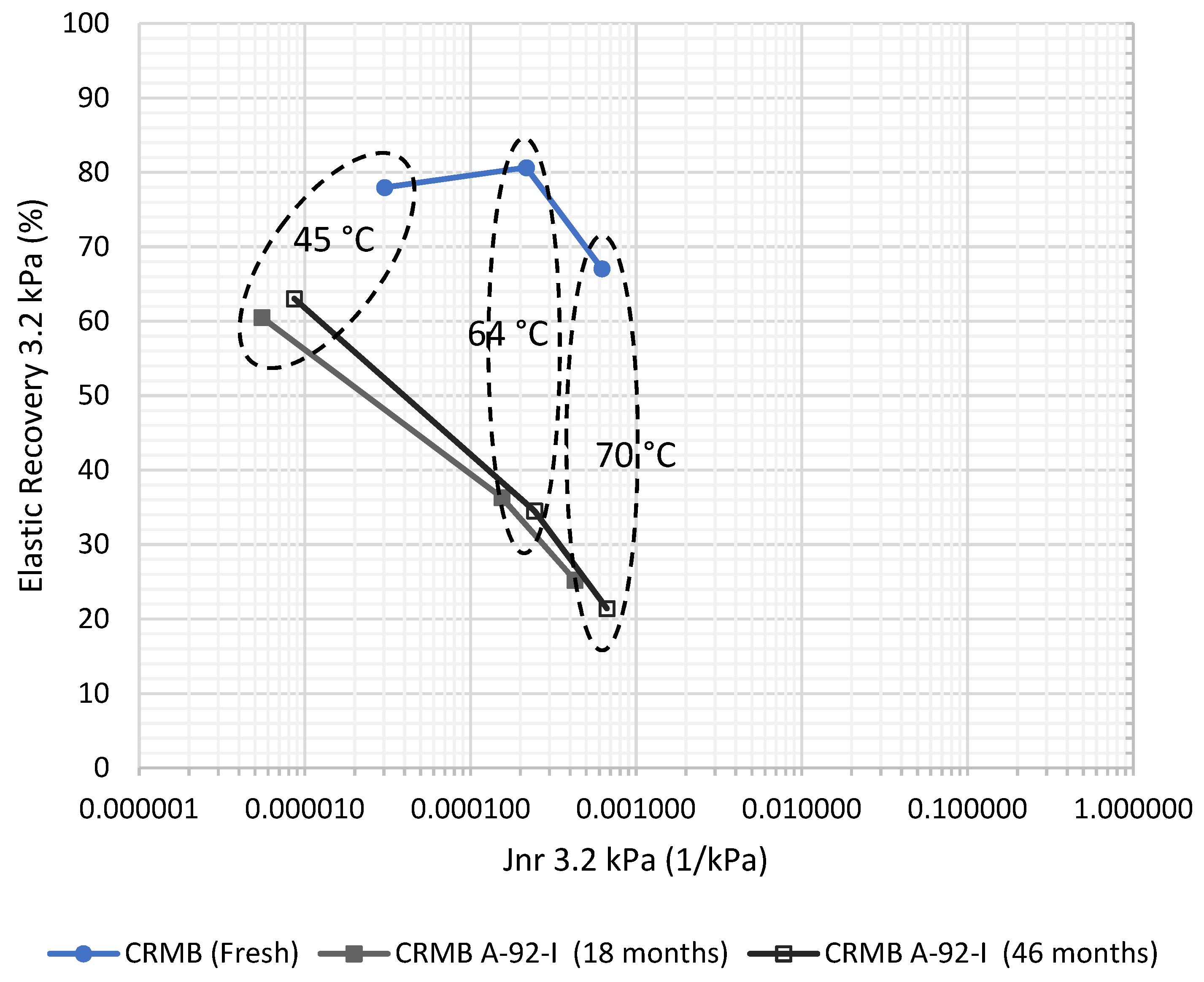
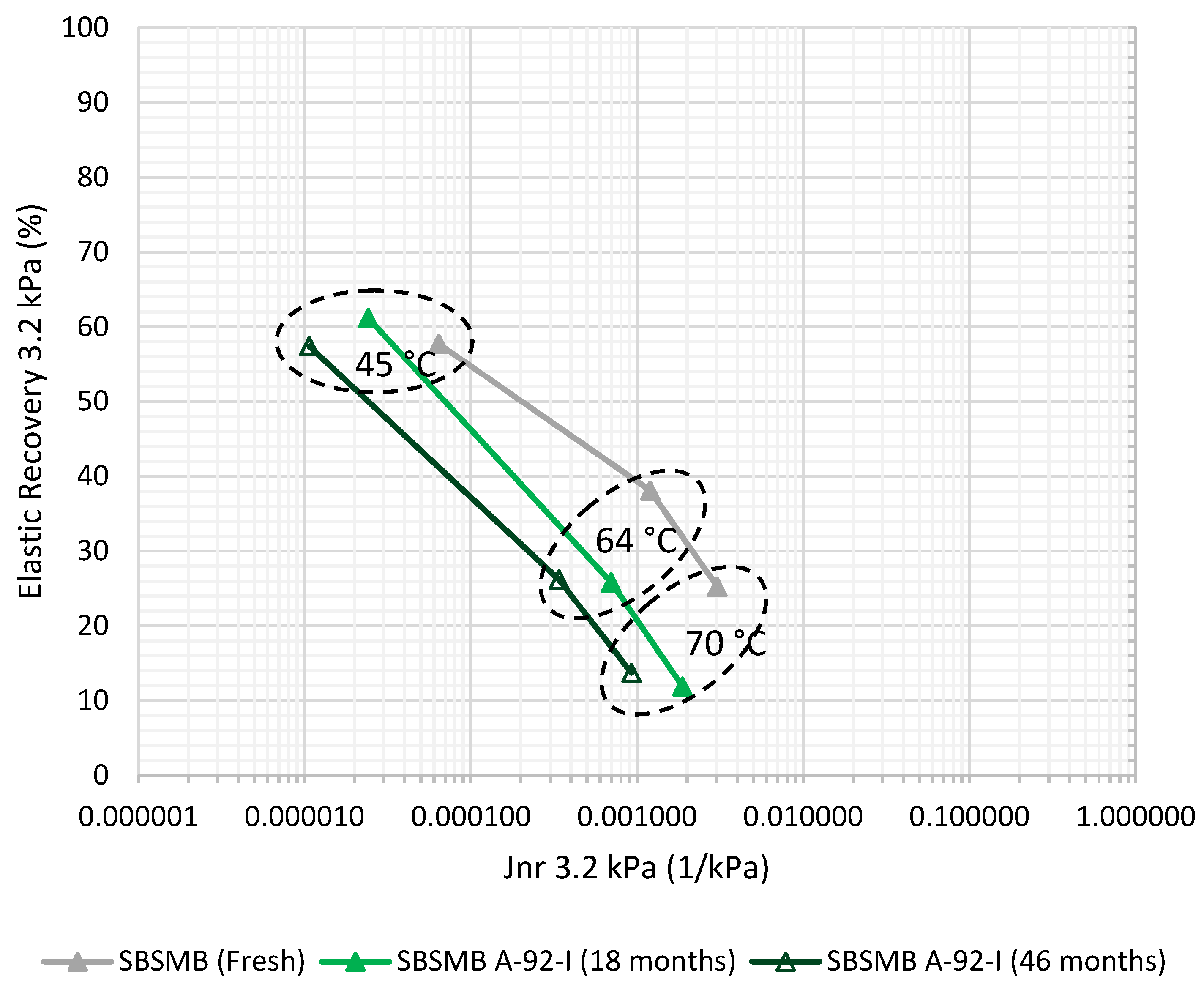
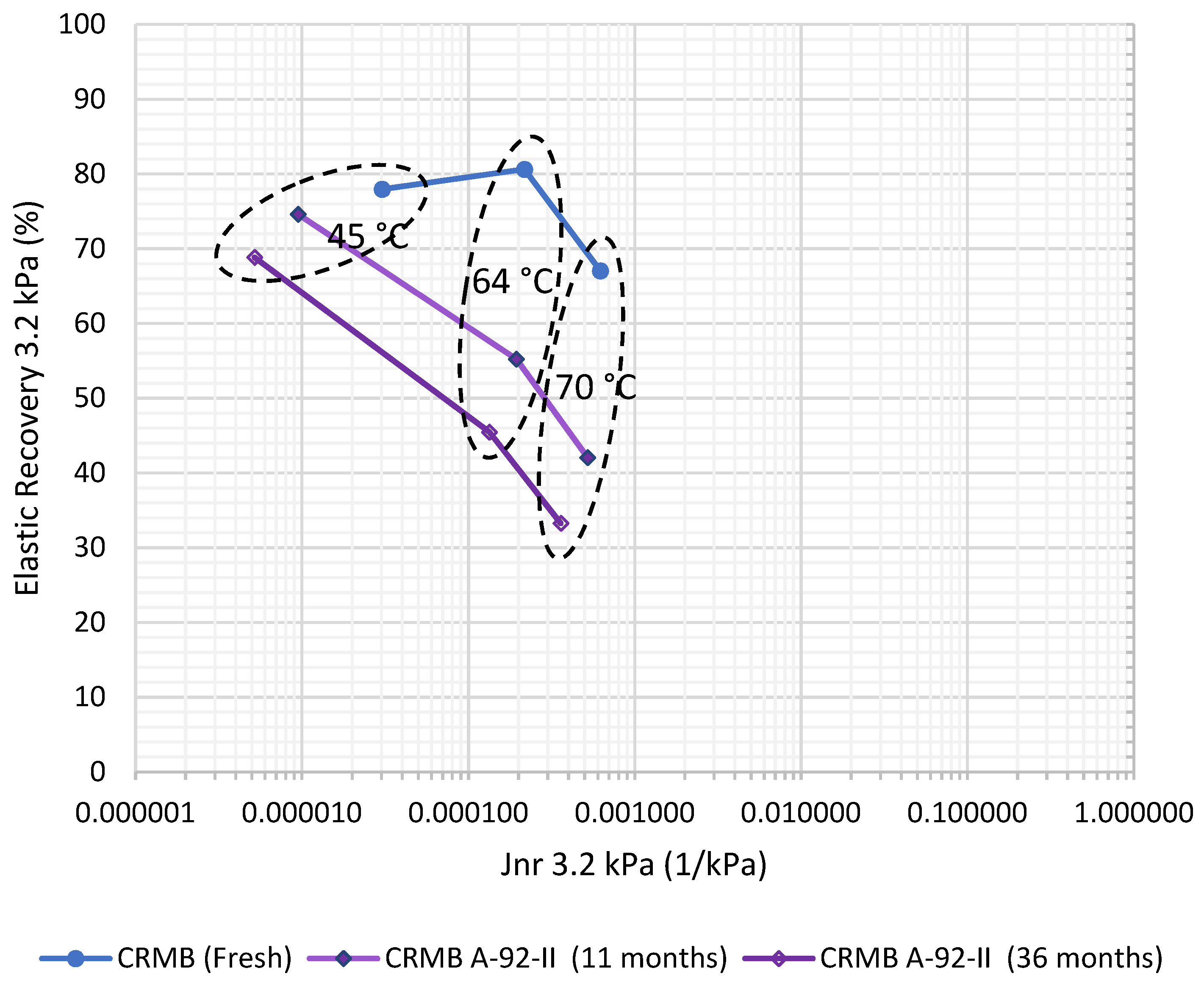
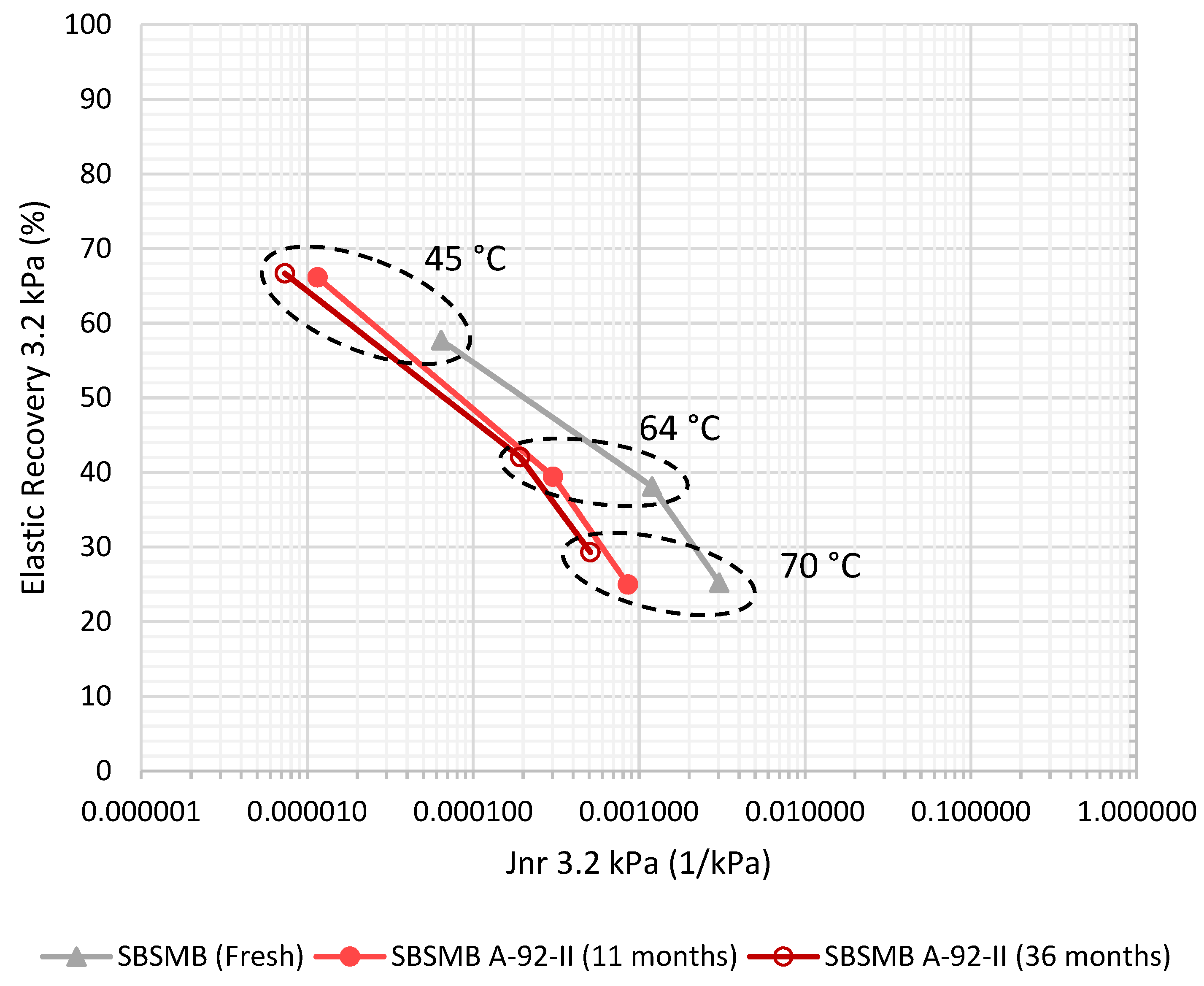
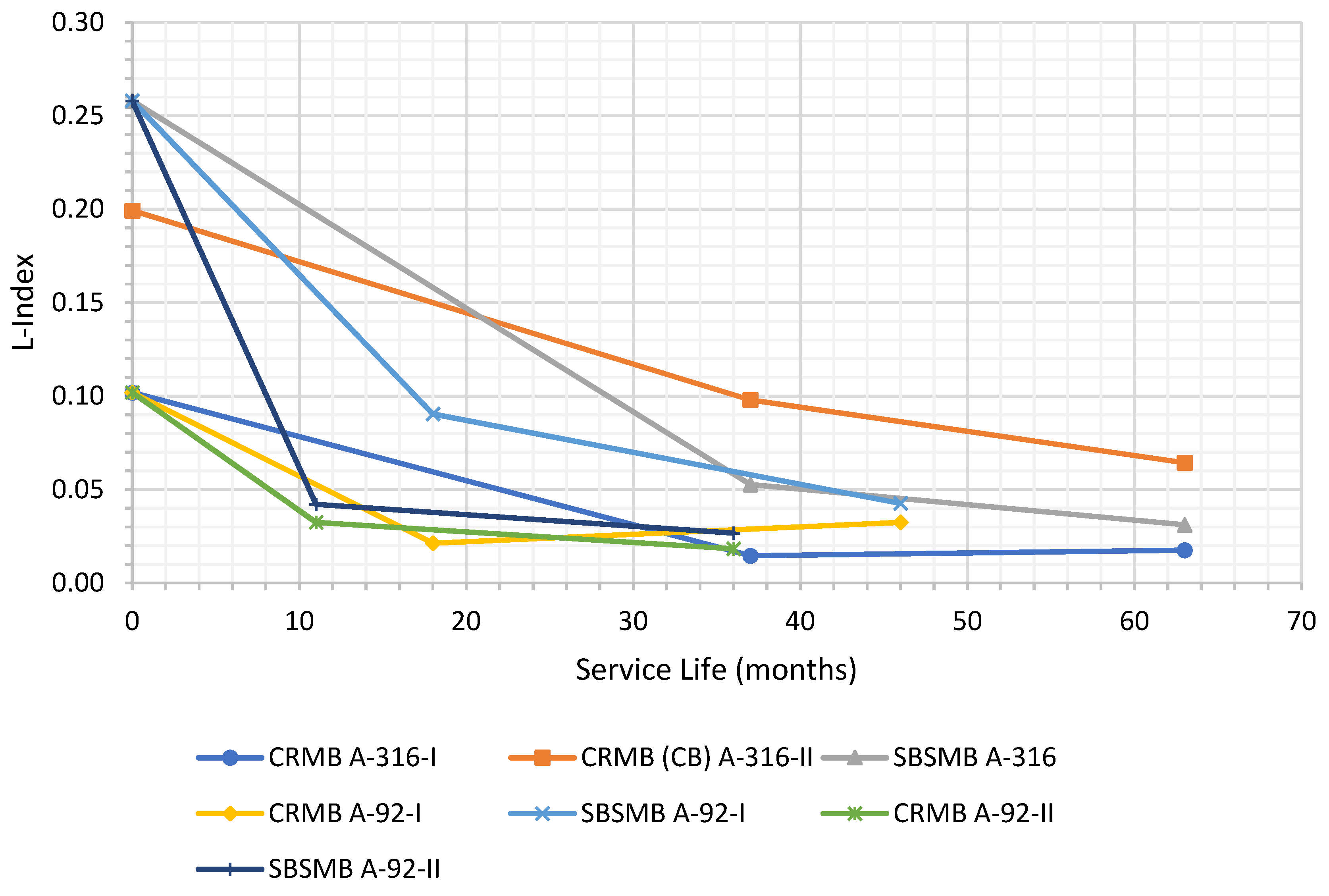
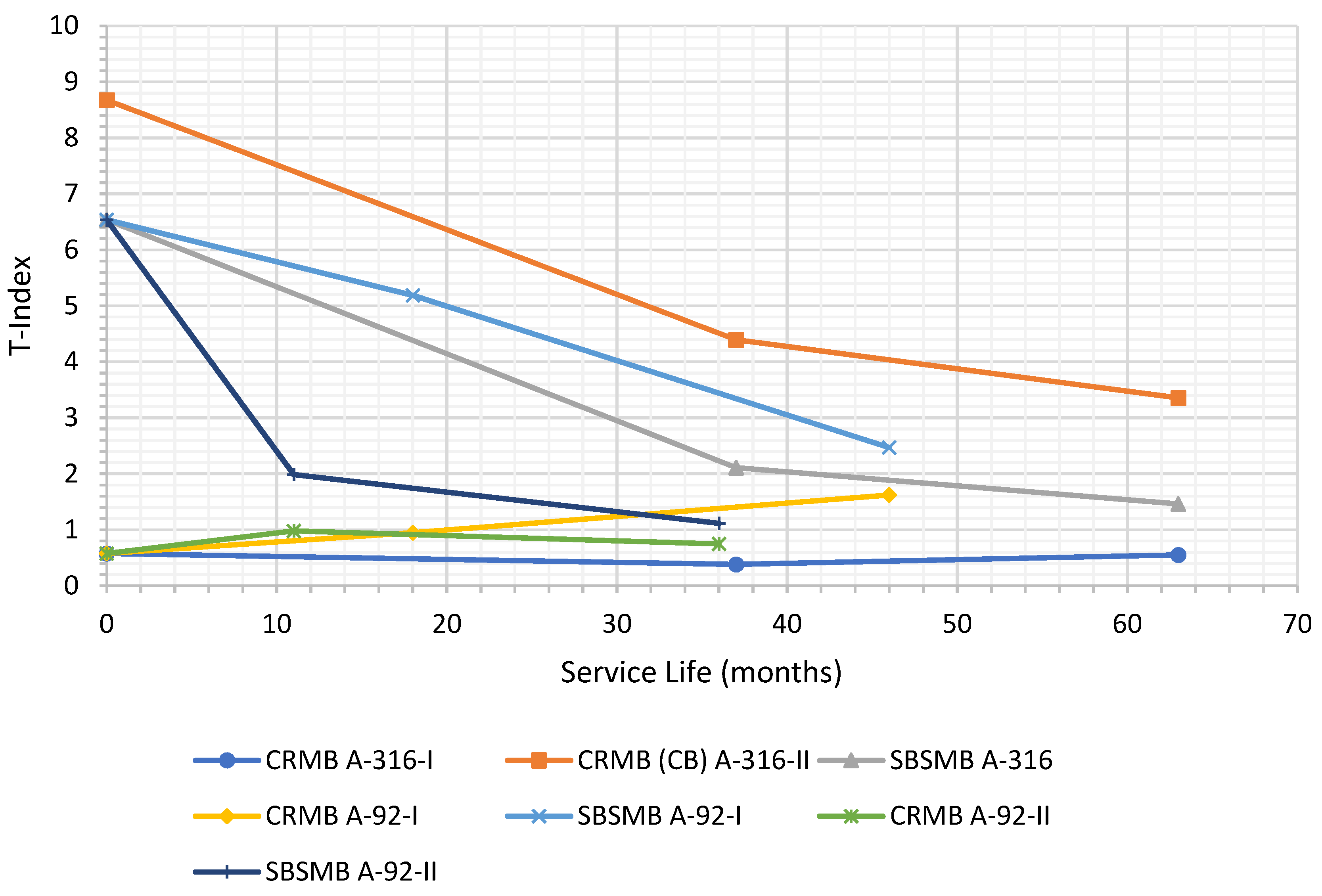
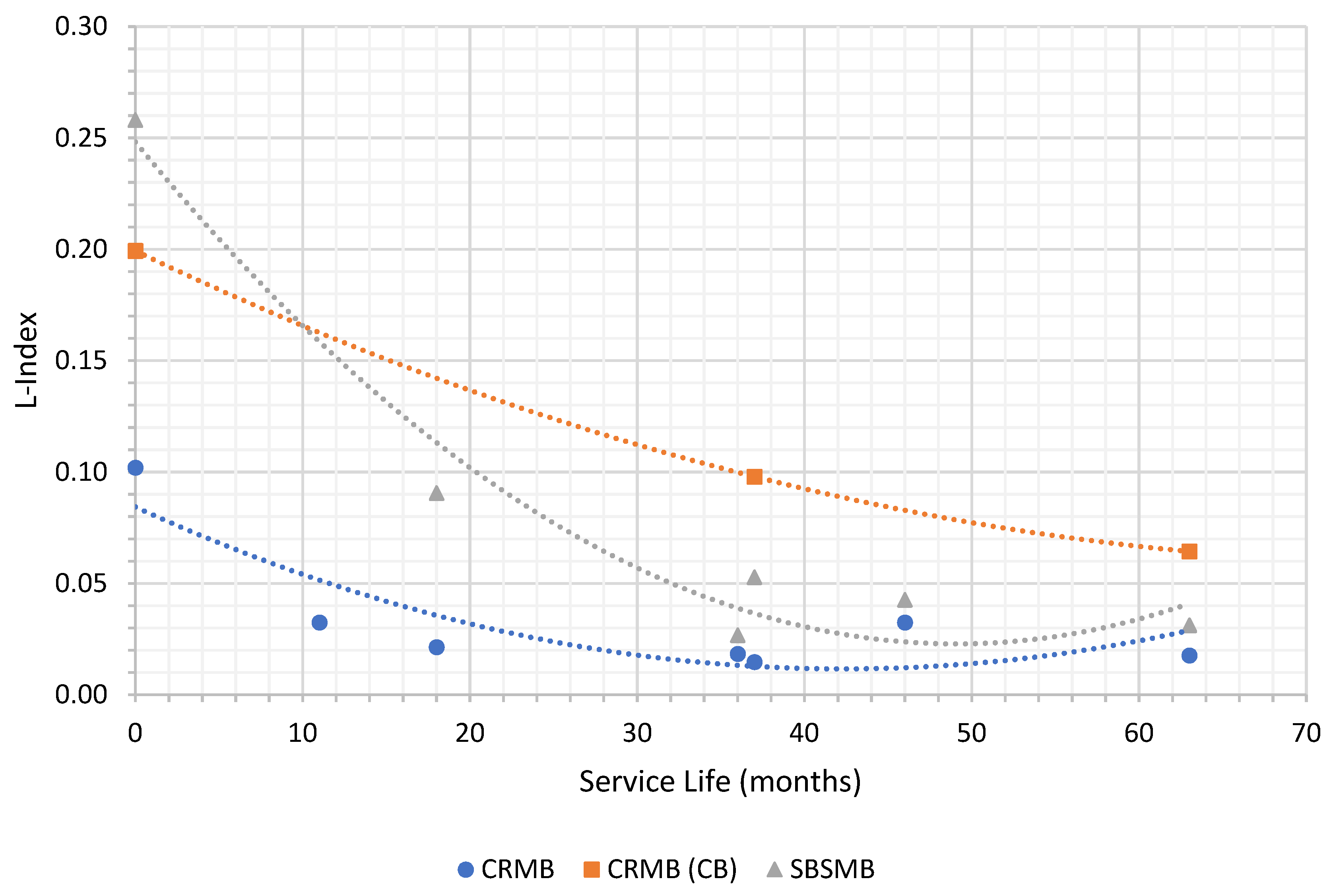
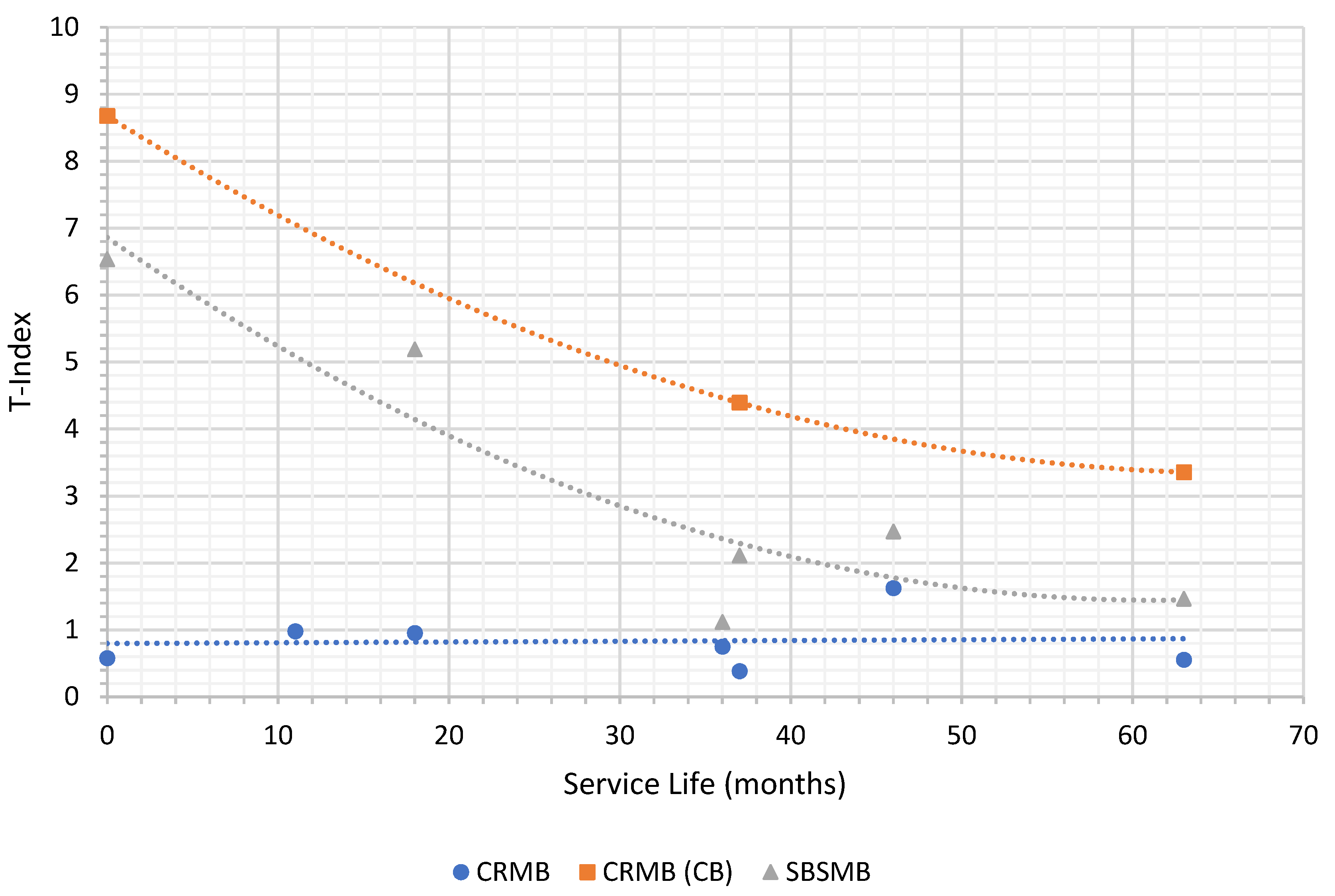
| A-316-I And A-316-II | A-92-I | A-92-II | |
|---|---|---|---|
| Date of traffic opening | November 2015 | September 2017 | July 2018 |
| Annual Average Daily Traffic (number of vehicles) | 8000 | 18,000 | 11,000 |
| Percentage of heavy traffic (of the total number of vehicles) | 8 | 17 | 7 |
| Climate conditions | ~750 m above sea level; rarely frost/snow on the road surface during autumn/winter; maximum average temperatures in summer ~36 °C; minimum average temperatures in winter ~4 °C | ~1400 m above sea level; very frequent frost/snow on the road surface during autumn/winter; maximum average temperatures in summer ~30 °C; minimum average temperatures in winter ~1 °C | ~1100 m above sea level; frequent frost/snow on the road surface during autumn/winter; maximum average temperatures in summer ~33 °C; minimum average temperatures in winter ~4 °C |
| Core Extraction Campaign | A-316-I | A-316-II | A-92-I | A-92-II |
|---|---|---|---|---|
| 1 | 37 months (December 2018) | 37 months (December 2018) | 18 months (March 2019) | 11 months (June 2019) |
| 2 | 63 months (February 2021) | 63 months (February 2021) | 46 months (July 2021) | 36 months (July 2021) |
Publisher’s Note: MDPI stays neutral with regard to jurisdictional claims in published maps and institutional affiliations. |
© 2022 by the authors. Licensee MDPI, Basel, Switzerland. This article is an open access article distributed under the terms and conditions of the Creative Commons Attribution (CC BY) license (https://creativecommons.org/licenses/by/4.0/).
Share and Cite
Albornoz, F.J.S.-C.d.; Moreno-Navarro, F.; Sol-Sánchez, M.; Rubio-Gámez, M.d.C.; Saiz, L. Ageing of Crumb Rubber Modified Bituminous Binders under Real Service Conditions. Sustainability 2022, 14, 11189. https://doi.org/10.3390/su141811189
Albornoz FJS-Cd, Moreno-Navarro F, Sol-Sánchez M, Rubio-Gámez MdC, Saiz L. Ageing of Crumb Rubber Modified Bituminous Binders under Real Service Conditions. Sustainability. 2022; 14(18):11189. https://doi.org/10.3390/su141811189
Chicago/Turabian StyleAlbornoz, Francisco Javier Sierra-Carrillo del, Fernando Moreno-Navarro, Miguel Sol-Sánchez, María del Carmen Rubio-Gámez, and Leticia Saiz. 2022. "Ageing of Crumb Rubber Modified Bituminous Binders under Real Service Conditions" Sustainability 14, no. 18: 11189. https://doi.org/10.3390/su141811189







